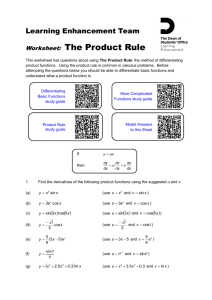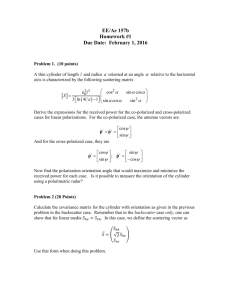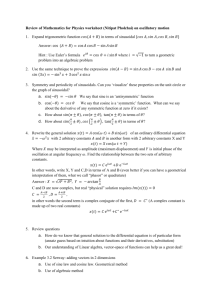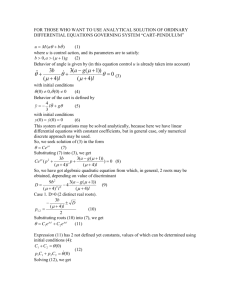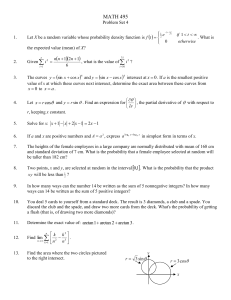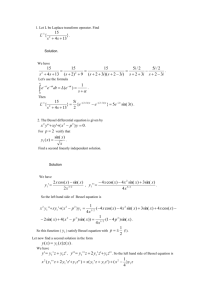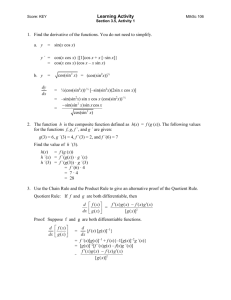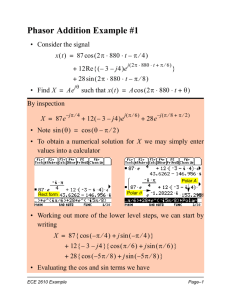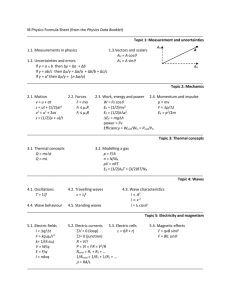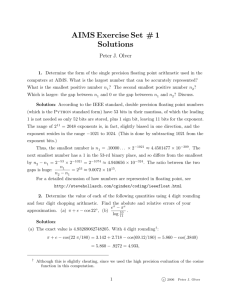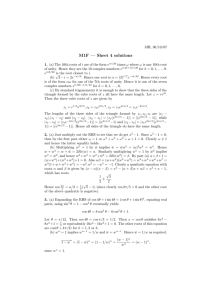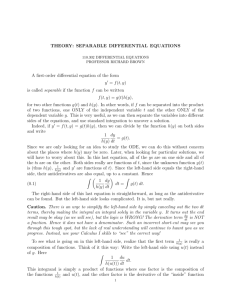Solutions - Missouri State University
advertisement
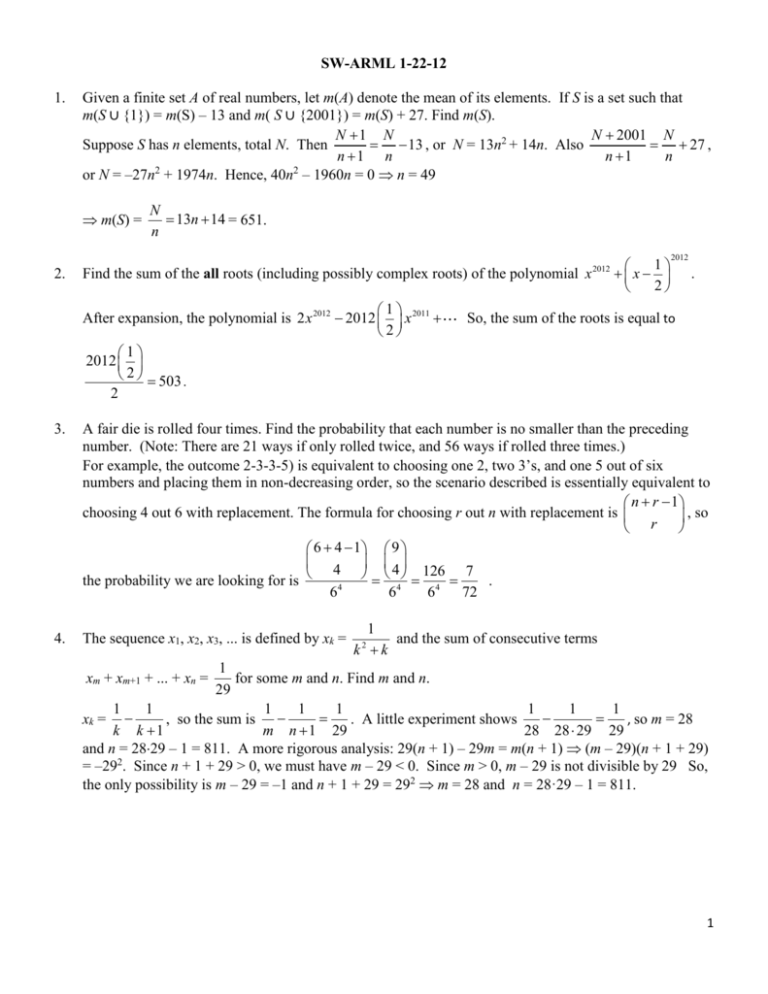
SW-ARML 1-22-12
1.
Given a finite set A of real numbers, let m(A) denote the mean of its elements. If S is a set such that
m(S ∪ {1}) = m(S) – 13 and m( S ∪ {2001}) = m(S) + 27. Find m(S).
N 1 N
N 2001 N
13 , or N = 13n2 + 14n. Also
27 ,
Suppose S has n elements, total N. Then
n 1 n
n 1
n
or N = –27n2 + 1974n. Hence, 40n2 – 1960n = 0 n = 49
m(S) =
2.
N
13n 14 = 651.
n
Find the sum of the all roots (including possibly complex roots) of the polynomial x
1
After expansion, the polynomial is 2 x 2012 2012 x 2011
2
1
2012
2 503 .
2
3.
2012
1
x
2
2012
.
So, the sum of the roots is equal to
A fair die is rolled four times. Find the probability that each number is no smaller than the preceding
number. (Note: There are 21 ways if only rolled twice, and 56 ways if rolled three times.)
For example, the outcome 2-3-3-5) is equivalent to choosing one 2, two 3’s, and one 5 out of six
numbers and placing them in non-decreasing order, so the scenario described is essentially equivalent to
n r 1
choosing 4 out 6 with replacement. The formula for choosing r out n with replacement is
, so
r
6 4 1 9
4 4 126 7
4 4
the probability we are looking for is
.
64
6
6
72
4.
The sequence x1, x2, x3, ... is defined by xk =
1
and the sum of consecutive terms
k k
2
1
for some m and n. Find m and n.
29
1
1
1
1
1
1
1
1
xk =
, so the sum is
. A little experiment shows
, so m = 28
k k 1
m n 1 29
28 28 29 29
and n = 2829 – 1 = 811. A more rigorous analysis: 29(n + 1) – 29m = m(n + 1) (m – 29)(n + 1 + 29)
= –292. Since n + 1 + 29 > 0, we must have m – 29 < 0. Since m > 0, m – 29 is not divisible by 29 So,
the only possibility is m – 29 = –1 and n + 1 + 29 = 292 m = 28 and n = 28·29 – 1 = 811.
xm + xm+1 + ... + xn =
1
5.
The solutions to log 225 x + log 64 y = 4, logx225 – logy64 = 1 are (x, y) = (x1, y1) and (x2, y2). Find log30(
x1 y1 x2 y2 ).
1
1
1 1
, logy64 = , so equations become 1 and,
a
a
a b
2
a + b = 4 a – 6a + 4 = 0. Solving, ( log 225 x , log 64 y ) = (a, b) = ( 3 5 , 1 5 ) or ( 3 5 , 1 5 ).
Put a = log 225 x , b = log 64 y . Then logx225 =
Hence, log 225 x1 x2 log 225 x1 log 225 x2 6
x1x2 = 2256 = 1512, and log64 y1 y2 log 64 y1 log 64 y2 2 y1y2 = 642 = 212. Therefore,
log 30 ( x1 y1 x2 y2 ) log 30 (1512 212 ) log 30 (3012 ) 12
6.
S is a set of positive integers containing 1 and 2002. No elements are larger than 2002. For every n in S,
the arithmetic mean of the other elements of S is an integer. What is the largest possible number of
elements of S?
Let S have k +1 elements with sum N. Then k divides N – 1 and N – 2002 and hence also 2001 =
3·23·29. If m is any element of S, then k divides N – m and hence m – 1 m 1 (mod k). So the largest
element is at least 1 + k2 (with the elements being 1, 1 + k, 1 + 2k, …..) Since 2002 is the largest
element, k < 45. Thus the largest possible k is 29. For example: 1, 30, 59, 88, 117, 146, 175, 204, 233, ...
, 813, 2002.
7.
a, b, c are positive integers forming an increasing geometric sequence, b – a is a square, and
log6a + log6b + log6c = 6. Find a + b + c.
log6a + log6b + log6c = 6 is equivalent to abc = 66. a, b, c forming a geometric progression is equivalent
to b2 = ac, so b3 = 66, and b = 36. b – a is a square, so a = 11, 20, 27, 32, 35. But a divides 64, so a = 27.
Hence c = 48 a + b + c = 111.
8.
9.
log n 1
.
2
1
1
6
sin x cos x =
, so (sin x + cos x)2 = sin2x + 2 sin x cos x + cos2x = 1 + = . Hence
10
5
5
6
12
log12
log10
log12 1
log(sin x + cos x) = log( (sin x + cos x)2 )1/2 = ½ log = ½ log
=
5
10
2
2
n = 12.
Find n such that log sin x log cos x 1 , log sin x cos x
Find the volume of the set of points that are inside or within one unit of a rectangular 3 4 5 box.
The box is 60. There are four quarter-cylinders length 3, four quarter-cylinders length 4, and four
quarter-cylinders length 5, 3π + 4π + 5 π = 12π. There are eight one-eighth spheres at the vertices, total
4π
40π
, and there are boxes height 1 on each face, 12 + 12+ 15 + 15 + 20 + 20 = 94. Total 154 +
.
3
3
10. N is the largest multiple of 8 which has no two digits the same. What is N mod 1000?
The best we can hope for is to use each digit just once, and for the larger digits to occur earlier, and N
can have at most 10 digits. Any multiple of 1000 is divisible by 8, so 9876543000 is a multiple of 8.
Now 210 and 201 are not multiples of 8. The next best is 120. So the number is 9876543120, with
residue 120.
2







